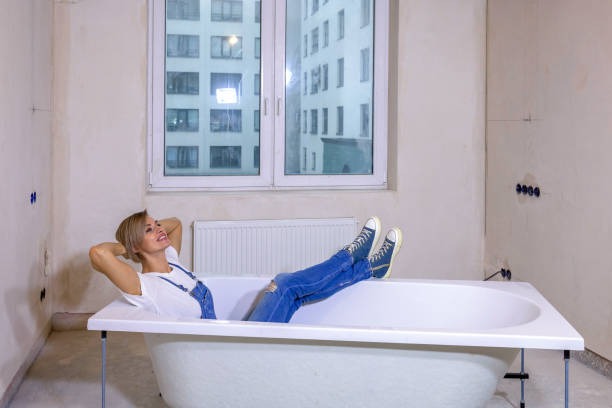Installing a bathtub is a significant home improvement project that requires careful planning and consideration. A new bathtub can enhance the aesthetics of your bathroom and provide a luxurious space for relaxation. However, before you proceed, it is essential to consider several factors to ensure the installation process goes smoothly and the bathtub meets your needs.
Assessing Space and Size
The first step in planning a bathtub installation is assessing the available space in your bathroom. Consider the dimensions of your bathroom and the space where the bathtub will be located. It is important to choose a bathtub size that fits comfortably in the space without overcrowding the room. Additionally, ensure there is enough space for other fixtures, such as toilets and sinks, to maintain a functional layout.
Budgeting for the Project
Budgeting effectively is crucial when planning for a bathtub installation. Bathtub prices can vary widely based on the material, brand, and style. Apart from the cost of the bathtub itself, it is important to account for additional expenses such as plumbing, installation, and potential bathroom renovations. Setting a realistic budget helps prevent overspending and ensures all aspects of the project are covered.
Choosing the Right Material
Bathtubs are available in various materials, each with distinct advantages and disadvantages. Common materials include acrylic, cast iron, and fibreglass. Acrylic bathtubs are lightweight and relatively inexpensive, while cast iron options are durable and retain heat well. Fibreglass bathtubs are affordable and easy to install but may be less durable over time. Consider factors such as durability, weight, maintenance, and aesthetics when selecting the material for your bathtub.
Deciding on a Style
Another important consideration is the style of the bathtub. The market offers a range of styles, including freestanding, alcove, corner, and drop-in bathtubs. Freestanding bathtubs create an elegant focal point in the bathroom, whereas alcove bathtubs are practical and space-saving. Selecting the right style depends on your bathroom design, personal preferences, and the existing plumbing setup.
Evaluating Plumbing and Infrastructure
Before proceeding with the installation, it is crucial to evaluate the existing plumbing and infrastructure. Ensure that the plumbing lines can accommodate a new bathtub and are in good condition. In some cases, plumbing modifications may be necessary, which could affect your budget and timeline. Consulting a professional plumber can help identify any potential issues early in the planning stage.
Accessibility and Safety Features
Incorporating accessibility and safety features is important, especially if the bathtub will be used by children or elderly individuals. Consider installing grab bars, non-slip surfaces, and adjustable showerheads to enhance safety. These features not only improve the user experience but also comply with safety standards for bathrooms.
Installation and Professional Assistance
While some homeowners may attempt to install a bathtub themselves, hiring a professional is recommended to ensure a secure and efficient installation. Professionals have the skills and experience necessary to handle unexpected challenges and ensure the bathtub is installed correctly. Professional installation can prevent potential issues and extend the lifespan of the bathtub.
Impact on Property Value
Installing a new bathtub can potentially increase your property’s value, particularly if it enhances the bathroom’s appearance and functionality. A well-designed bathroom with modern features is appealing to potential buyers and may lead to a higher selling price. However, ensure the installation does not compromise the overall layout and flow of the bathroom.
Post-Installation Care and Maintenance
Once the bathtub is installed, regular care and maintenance are essential to preserve its condition and extend its lifespan. Follow manufacturer guidelines for cleaning and maintenance, using appropriate cleaning products to prevent damage. Regularly check for leaks and address any issues promptly to avoid extensive repairs in the future.
Exploring Additional Bathroom Supplies
In addition to a new bathtub, consider upgrading other bathroom supplies to complete the transformation. New fixtures, lighting, and storage solutions can enhance the overall design and functionality of the bathroom. Coordinating these elements can create a cohesive and inviting space that meets your needs.
Environmental Considerations
When selecting a bathtub, consider its environmental impact. Look for eco-friendly options that reduce water consumption and are made from sustainable materials. This not only benefits the environment but also aligns with modern trends towards sustainability.
Checking Local Regulations
Before installation, check local regulations and building codes to ensure compliance. Some areas have specific requirements for plumbing and installations, and obtaining necessary permits may be necessary. Following these regulations is vital to avoid fines and other legal issues.
User Satisfaction and Comfort
Ultimately, the goal of installing a new bathtub is to enhance user satisfaction and comfort. Invest time in trying out various models and styles to find one that meets your comfort preferences. Consider features such as depth, length, and additional amenities like jets or built-in seating for an enhanced bathing experience.
Conclusion
Installing a bathtub is a worthwhile investment that can boost the value and appeal of your bathroom. By considering these factors—such as space, budget, material, style, and professional installation—homeowners can ensure a successful project. Thorough planning and informed decisions will result in a beautiful, functional, and comfortable space for relaxation and enjoyment.



